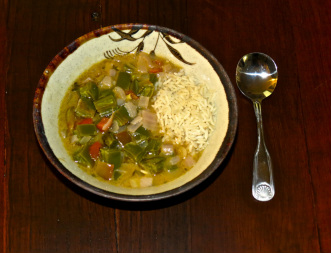
Bowl of cactus leaf gumbo on antique French farm table
One morning, I went out to my garden and discovered that coyotes had climbed up our large cactus to eat the half-ripe fruits. All the prickly pears (tunas) I had looked forward to making into jam and drinks were gone.
Also gone were many of the cactus's huge leaves. They had not been strong enough to support the coyotes’ weight and now littered the ground. I planted most in my cactus garden; two I kept for cooking; one led to this recipe.
If you have not made gumbo before, you may wish to refer to my earlier post "Cajun Gumbo Made Easy."
Cactus Leaf Gumbo
Ingredients
3 cups nopales (cactus leaves), thorns removed and chopped into
½-inch cubes, measured after chopping
olive oil for coating
salt
½ cup canola oil or other cooking oil with a mild flavor
½ cup white flour
3 medium onions, chopped into ½-inch squares
2 green bell peppers, chopped into ½-inch squares
1 cup sliced celery
6 cups cups “no chicken” chicken broth or tomato-free vegetable broth
3–4 bay leaves (fresh or dried)
6–8 large sprigs of thyme (any edible variety) or 1 teaspoon dried thyme
2 teaspoons chopped garlic
1 teaspoon ground chipotle chile pepper
¼ teaspoon ground cayenne pepper
Tabasco brand or Crystal brand hot sauce to taste
3 cups uncooked converted rice
1 teaspoon filé powder
Instructions
1. Set the oven to 350°F. Toss the nopales cubes with a little olive oil and salt. Spread on a baking sheet with a nonstick coating or lined with a nonstick mat. Bake for 15 to 25 minutes, or until they have given up their moisture and become soft. Let sit until cool enough to handle.
2. Meanwhile, make a brown roux: Heat the ½-cup oil in a heavy-bottomed kettle. Gradually add the flour, whisking constantly. Cook until the mixture turns the color of peanut butter, being careful not to burn it. It should smell of toasted nuts.
3. Add the onions, green bell peppers, and celery and sauté for 5 minutes or until the vegetables start to soften.
4. Add 1 cup broth and stir over medium heat until the mixture is very thick. Continue adding broth 1 cup at a time until the mixture has the consistency of a runny sauce or a thick stew. This will take 5 to 6 cups of broth.
5. Rinse the oil, salt, and sap off of the baked nopale cubes and add to the mixture. Stir in bay leaves, thyme sprigs or dried thyme, chopped garlic, chipotle powder, cayenne, and hot sauce.
6. Simmer the gumbo for 1 to 4 hours.
7. Cook rice according to rice cooker or package directions to be ready at mealtime.
8. When rice is done, add filé powder to gumbo and remove thyme stems and bay leaves.
9. Serve the gumbo in bowls over rice.
Also gone were many of the cactus's huge leaves. They had not been strong enough to support the coyotes’ weight and now littered the ground. I planted most in my cactus garden; two I kept for cooking; one led to this recipe.
If you have not made gumbo before, you may wish to refer to my earlier post "Cajun Gumbo Made Easy."
Cactus Leaf Gumbo
Ingredients
3 cups nopales (cactus leaves), thorns removed and chopped into
½-inch cubes, measured after chopping
olive oil for coating
salt
½ cup canola oil or other cooking oil with a mild flavor
½ cup white flour
3 medium onions, chopped into ½-inch squares
2 green bell peppers, chopped into ½-inch squares
1 cup sliced celery
6 cups cups “no chicken” chicken broth or tomato-free vegetable broth
3–4 bay leaves (fresh or dried)
6–8 large sprigs of thyme (any edible variety) or 1 teaspoon dried thyme
2 teaspoons chopped garlic
1 teaspoon ground chipotle chile pepper
¼ teaspoon ground cayenne pepper
Tabasco brand or Crystal brand hot sauce to taste
3 cups uncooked converted rice
1 teaspoon filé powder
Instructions
1. Set the oven to 350°F. Toss the nopales cubes with a little olive oil and salt. Spread on a baking sheet with a nonstick coating or lined with a nonstick mat. Bake for 15 to 25 minutes, or until they have given up their moisture and become soft. Let sit until cool enough to handle.
2. Meanwhile, make a brown roux: Heat the ½-cup oil in a heavy-bottomed kettle. Gradually add the flour, whisking constantly. Cook until the mixture turns the color of peanut butter, being careful not to burn it. It should smell of toasted nuts.
3. Add the onions, green bell peppers, and celery and sauté for 5 minutes or until the vegetables start to soften.
4. Add 1 cup broth and stir over medium heat until the mixture is very thick. Continue adding broth 1 cup at a time until the mixture has the consistency of a runny sauce or a thick stew. This will take 5 to 6 cups of broth.
5. Rinse the oil, salt, and sap off of the baked nopale cubes and add to the mixture. Stir in bay leaves, thyme sprigs or dried thyme, chopped garlic, chipotle powder, cayenne, and hot sauce.
6. Simmer the gumbo for 1 to 4 hours.
7. Cook rice according to rice cooker or package directions to be ready at mealtime.
8. When rice is done, add filé powder to gumbo and remove thyme stems and bay leaves.
9. Serve the gumbo in bowls over rice.


 RSS Feed
RSS Feed